Saturday, July 10, 2004
Silvered Æ antoninianus, Salonina, Cyzikus, Göbl 1547Bf
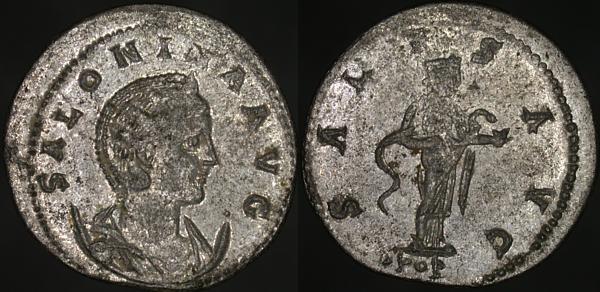
SALONINA AVG, Draped diademed bust right on crescent, one pellet beneath bust | SALVS AVG, Salus standing facing, head right, holding snake in arms, feeding it from small patera right. SPQR in exergue.
A recent acquisition, my first Salonina imperial from Cyzikus, this features Salus, Roman goddess of health, usually seen, as here, in association with a snake.
Friday, July 09, 2004
Æ28, Tarsus in Cilicia, Salonina, SNG von Aulock 6081
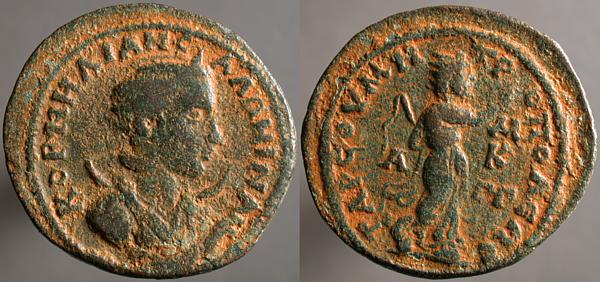
ΚΟΡΝΗΛΙΑΝ C_ΑΛΩΝΙΝΑ, Diademed draped bust right, crescent behind shoulders | ΤΑΡCΟV ΜΗ_ΤΡ_ΟΠΟΛΕΩC, Helios advancing right, hand raised right, carrying whip behind. Α in left field, Μ / Κ / Γ Γ in right.
Don't see many Helios / Sol reverses for empresses, but provincial cities, even important ones like Tarsus, didn't always make such niceties a primary concern. Note that he's wearing the radiate crown you've seen on so many of the coins of the emperors that I've posted. Yesterday, for instance.
Thursday, July 08, 2004
Æ antoninianus, Gallienus, Rome, Göbl 352s
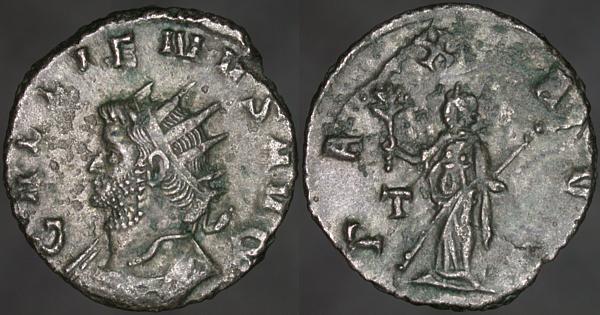
GALLIENVS AVG, Radiate cuirassed bust left | PAX AVG, Pax standing facing, head left, holding branch left and long scepter transverse. T in left field.
Lacking newspapers or television, the Romans seem to have tried to inform public opinion with coins. While the some of the Julio-Claudians seem to have insisted on portraits of painful honesty, Augustus, who died in his mid-seventies, never looks anything but youthful on his coins, and, over the next 500 years, most of his successors are portrayed as they wanted to be seen, not as they were.
Likewise, the reverses show various encouraging themes, as here, Pax holding an olive branch, always a popular notion, regardless of what was actually happening in the empire.
Wednesday, July 07, 2004
AR quinarius, Octavian, Rome, c. 28 BCE, RIC 276
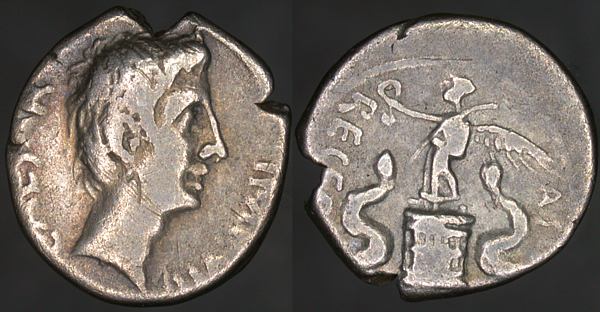
CAESAR IMP VII, Bare head right | ASIA RECEPTA, Victory standing left on cista mystica, holding wreath left and palm over shoulder. All flanked by two snakes.
Julius Caesar, who died 15 March, 44 BCE, with no heir, in his will adopted his young relative by marriage, Octavius, who then took the name Caius Julius Caesar Octavianus.
Caesar's son was entitled to Caesar's property, which was left to him in the will, but no part of Caesar's title, dictator for life, was heritable. Marc Antony, who held consular office with Caesar at his death, certainly had no intention of ceding power to the young man.
The events of the next years, the shifting alliances, the back-alley knifings and open armed conflict are considerably more complex for me to fully grasp, much less attempt to present here. In brief, Octavian and his general Marcus Agrippa completed their dominance of Rome with the defeat (and suicide) of Antony and Cleopatra near Alexandria, 1 August, 30 BCE.
By 28 BCE, when this was issued, they had regained the province of Asia, which had been under Antony's control, which this quinarius commemorates. Victory holding wreath symbolizes victory, naturally, and the palm she carries the promise of peace subsequent to victory.
During the next year, Octavian would arrange a ceremony in which he surrendered his power to the Senate, which declared the restoration of the Roman Republic and immediately returned that power to Octavian, along with the epithet "Augustus."
Every subsequent emperor added the name Augustus to his own, seeking to gain a little of the glory of the man who ended nearly 15 years of civil war in the empire.
Henceforth, until Diocletian styled himself "Dominus" c. 285 CE, Rome would rigorously maintain the comfortable fiction of a Republic ruled by a Princeps, first among equals. The recognition that these were emperors is a modern one.
Tuesday, July 06, 2004
Æ33, Aspendos in Pamphylia, Valerian, cf. Lindgren III, 640
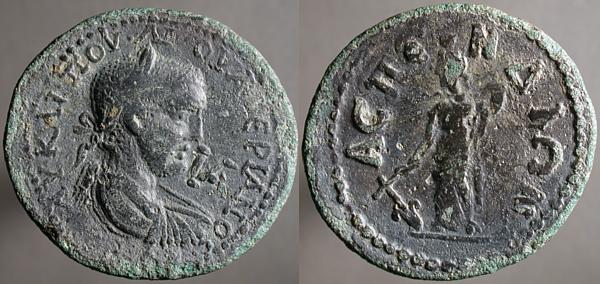
ΑV·ΚΑΙ·ΠΟV·ΛΙ·ΟVΑΛΕΡΙΑΝΟC, Laureate draped bust right, IA before | ΑCΠΕ_ΝΔΙΩΝ, Tyche standing facing, head left, holding cornucopia right.
Aspendos is now Belkiz, Turkey, and has some well-preserved ruins.
There's nothing very exciting about the very conventional Tyche reverse, it seems that every city that issued coins issued some featuring Tyche, the Greek Fortune or Fate. The merit of this coin is its state of preservation, with little original wear, and just a little deterioration from corrosion since, particularly around 3:00 on the obverse, and Tyche's head on the reverse.
Roman coins usually don't separate the words, or abbreviations, in the legend, just running them together as one long string, broken only if some bit of the design intrudes. This can add additional difficulty to reading a coin with badly worn legends. Sometimes, though, as here, they are clearly separated with pellets, collector jargon for the dots seen here in the obverse legend.
Monday, July 05, 2004
Silvered Æ antoninianus, Salonina, Rome, Göbl 491s
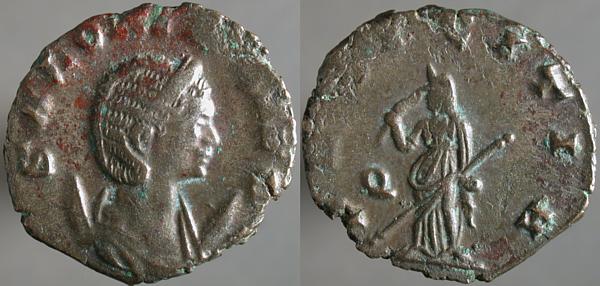
SALONINA AVG, Diademed draped bust right on crescent | PVDICITIA, Pudicitia standing left, sniffing posie left, holding transverse scepter. Q in left field.
Pudicitia, the little-noted Roman goddess of modesty and chastity, was a common theme for coins of the empresses. A compliment now and then never hurts.
Sunday, July 04, 2004
Æ20, Cyme in Aeolis, Gallienus, SNG Cop 162
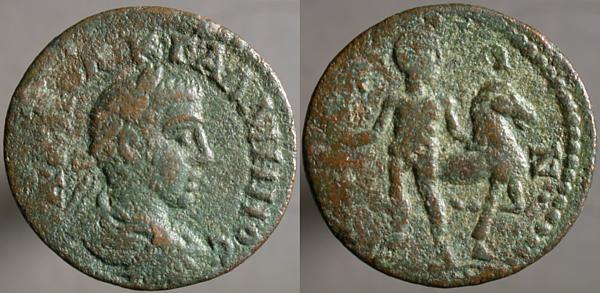
ΑΚ ΠΟ ΛΙΚ ΓΑΛΛΙΗΝΟC, Laureate draped cuirassed bust right | ΚV_ΜΑ_ΙΩ_Ν, Nude male figure standing facing, head right, holding globe left and bridled horse right.
There may be, or may not be, a mud-brick village where Cyme was, but once it was important. By 17-1/2 centuries ago, when this coin was produced, it was already in decline, not claiming any special merit on the small coins, not boasting a temple of the cult of the imperial family, just some local celebrity or diety and his horse.

